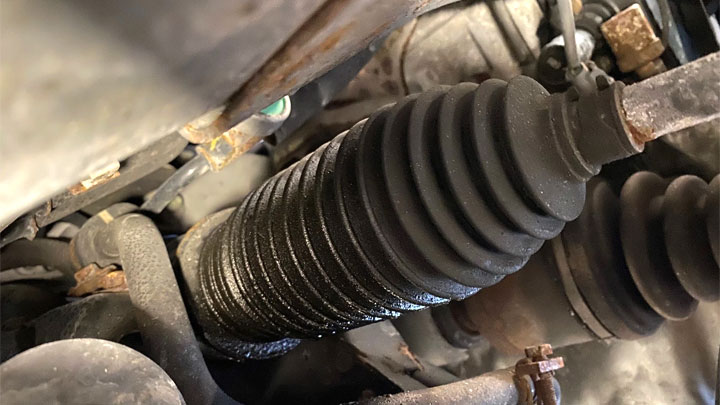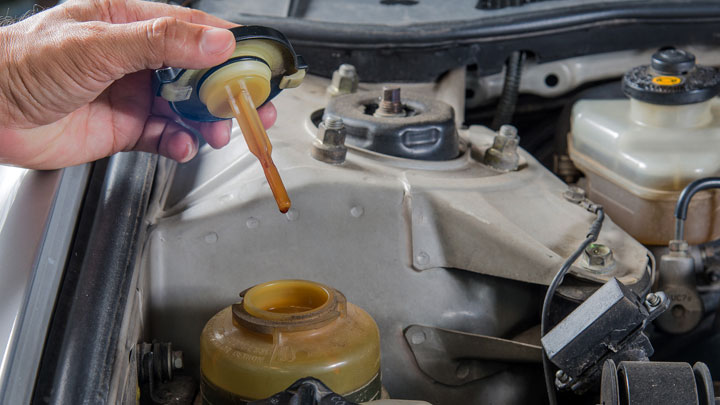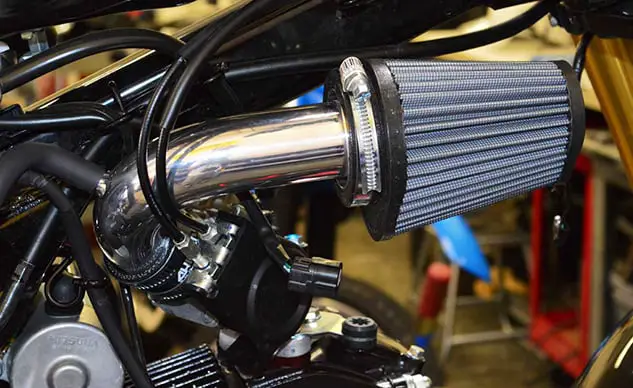Rack and Pinion Leak – Symptoms and How To Fix It
These days, Fixing Rack and Pinion Leak with power steering are standard on most vehicles. It’s easier to turn with power steering, but the added complexity of the system can make repairs more time-consuming and costly.
The design of a rack and pinion steering system is modified slightly when power steering is added to it. Fluid is added to both sides of a piston after the cylinder is placed in the rack. When hydraulic pressure is applied to one side of the piston, the piston is forced to move, turning the rack to aid with steering.
When most people think of an oil spot in their garage, they picture their car’s engine leaking oil onto the tarmac. Or maybe you think of a gearbox fluid leak instead. Even though both of these possible Rack and Pinion Leak sources need to be looked into more, the real source of the leak might be something else.

Top 5 Symptoms of a Rack and Pinion Leak
When a rack and pinion leak starts, there are often a number of signs that you can look out for. Even though not everyone will have all of these signs, they happen often enough to be worth noting.
Here are some of the most common signs that a rack and pinion leak is starting.
Must Read : Some Reasons why Your Car is Making Rattling Noise
How stiff the steering wheel is

A stiff steering wheel is one of the first signs that there is a break in the rack and pinion. This happens because the fluid leak makes the rack and pinion less smooth, which makes it hard to turn the steering wheel.
When a rack and pinion leak happens, the steering of a car can be affected in some ways. This usually happens when too much fluid has leaked out of the system, letting air into the system.
Some of these problems might even be followed by a humming or whining sound, like the ones above.
In some cases, you can get regular steering back by just topping off the power steering fluid. But in more serious cases, the handling might not get any better, especially if the car has been running for a long time without enough fluid and has overheated.
When this happens, the only way to fix the problem is to rebuild the whole rack and pinion leak system of the car.
Steering wheel vibrations
The steering wheel can also shake if there is a break in the rack and pinion leak. This happens because when there isn’t enough oil in the system, the steering wheel gets out of balance. This makes the steering wheel vibrate, which the driver can feel.
Strange Sounds When Turning

A rack and pinion leak that is leaking could also make noise when you turn from one way to another. This sound, which is usually caused by too much power steering fluid loss, is often described as a hum or a whine.
This loss of fluid lets air into the power steering system, which causes a lot of strange things to happen.
This loss of power steering fluid can happen in more than one place in the system. Even though fluid can be drained from broken lines or a broken pump, the rack and pinion itself is also a possible source of the problem. The rack and pinion will help you narrow down your search if you look at them carefully.
Running out of oil in the steering wheel reservoir

A noticeable drop in the fluid level in the power steering fluid tank is another sign of a leak in the rack and pinion. Because of the leak, fluid leaks out of the system, which means that the power steering fluid needs to be refilled often.
When a rack and pinion seal leaks, power steering fluid leaks out. This lowers the amount of fluid in the power steering system. How fast this fluid runs out depends on how bad the leak is.
In some situations, fluid could slowly leak out over a period of months. In other, more serious situations, fluid loss can happen a lot faster.
During routine maintenance, if you find that your power steering fluid seems lower than usual, you should carefully check your vehicle’s rack and pinion. This is especially true if you have never noticed that the power steering fluid tank in your car is low before.
Spots of oil on the ground

If you see puddles or spots of fluid under your car, it could mean that the rack and pinion are leaking. Most of the time, the fluid is red or brown and has a clear smell. Fixing the leak as soon as possible is important because moving with a leak can cause more damage to the system.
When a rack and pinion leak is happening, power steering oil quickly builds up along the underside of the car. This oil doesn’t just stick to the rack and pinion, but also to any other close parts that it gets on. Then, when a car is stopped, gravity drops this power steering fluid on the driveway or parking lot below.
Because of this, the sudden arrival of oily spots in a driveway is a good sign that something is wrong. Even though a leaky rack and pinion might not be the cause, it should be looked at more closely.
Why things happen
The most common reason why a power steering rack leaks is that a seal has broken. This is because the rack and pinion of a car are under a lot of hydraulic pressure, which makes it easy for leaks to happen.
Simply put, even the smallest cracks in the covers of a rack and pinion will let a lot of pressurised fluid leak out.
A standard rack and pinion leak assembly has three main seals: one at the point where the steering shaft enters the assembly, and one at each end. Each of these three seals is known to leak in some situations, especially as they get older and wear down from normal use.
The rubber that makes up a seal starts to break down over time. This wear and tear usually shows up as dry rot and cracks. Rubber seals can also dry out and shrink, which can cause them to come loose.
In any case, when this kind of damage is exposed to high-pressure power steering fluid, it quickly shows how bad it really is.
Is it safe to drive with a rack and pinion that is leaking?

It’s not a good idea to drive with a leaking rack and pinion, and it’s not safe to do so either. The rack and pinion is a key part of how the power steering system of a car works. So, a major problem with the rack and pinion can be very annoying or even dangerous.
If a vehicle’s rack and pinion leaks oil, the unit could fail in the long run. As fluid leaks out, the rack and pinion itself loses hydraulic power. This will make the turning of a car stiffer, so more force will need to be put on the steering wheel to turn.
Fluid loss can also cause the rack and pinion to get too hot, which can cause the rack and pinion to fail completely. This has the same effects as those described above, since all hydraulic steering assistance is lost. If this kind of problem happens, the rack and pinion will also need to be replaced.
Driving a car with a leaking rack and pinion is dangerous because a quick or unexpected loss of power steering can be very dangerous, especially if it happens on the highway.
If a driver doesn’t have enough strength to guide their car by hand, they are likely to get into an accident.
Whether to fix or replace

Most of the time, it’s much cheaper to replace an entire rack and pinion system than to try to fix individual fluid leaks within the unit.
This might seem strange when you think about how much a new rack and pinion costs, but the cost of labour to fix a rack and pinion often exceeds the cost of a new one.
So, the real cost of replacing a rack and pinion is about the same as the cost of fixing a rack and pinion.
Keeping this in mind, it seems likely that a person would be better off buying a whole new rack and pinion instead of fixing their old one, if there isn’t much of a price difference between the two.
A new rack and pinion will usually come with a warranty, but a rack that has been fixed is not likely to be covered by a guarantee. This is a big deal in and of itself, and it gives you even more peace of mind.
Here are the average costs to fix or replace a rack and pinion.
- Rack and Pinion Repair $500 to $1,200
- $750-$1,800 to fix the rack and pinion
FAQ’s
What happens when the rack and pinion break?
If your rack and pinion is leaky, you may be curious about what happens when the rack and pinion goes out. The first sign is that you can’t move the car. If a rack or pinion breaks, it can be very dangerous.
2. How long does it take to repair the rack and pinion?
People say that it takes 2 hours and a half to change a new rack and pinion. So, when you take the car to the mechanic, make sure you have enough time to wait for the repairman. You can also leave your car there and get it when you’re ready. How long it takes to replace the rack and pinion relies on the situation of the car or the repairman. But it won’t take more than 3 hours in most cases.
3.Can I drive if my rack and pinion are leaking?
As what happens to the car when the rack and pinion break, you won’t be able to move the car. We don’t think you should drive a car with a break in the rack and pinion. It could cost you your life and damage your car. If you haven’t let all the air out of your car, you can still drive it as long as you stay on a straight road.
4. How much does it cost to buy a new rack and pinion?
If your power steering rack is leaking, it would cost a lot to fix the gear assembly and the steering rack. On average, it costs between $500 and $1000 to fix a break in the pinion assembly and the steering rack. This would depend a lot on the model and type of your car. Rack and pinion leaks are so expensive to fix because even a tech can’t always fix the seals. Most rack and pinion leaks mean that the whole rack and pinion system needs to be replaced, even if most of it works fine.
One Last Thing
Can I drive with a rack and pinion leak? Well, you can drive with a leak, but driving with too little steering fluid is dangerous. It will be hard to make a turn in this weather. So, you should have it fixed as soon as you see a sign that it is leaking. Don’t forget to use our upkeep tips to fix your car better.
